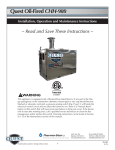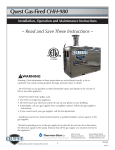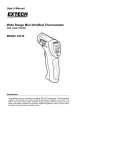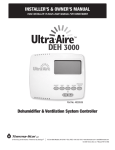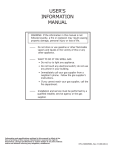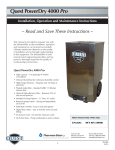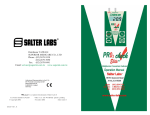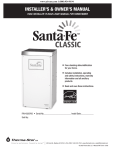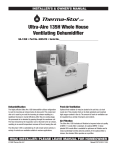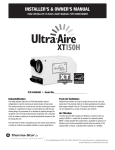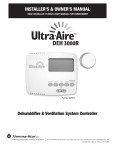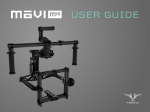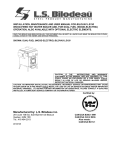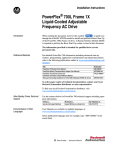Download Quest Gas Fired CHH-980 Installation, Operation and Maintenance
Transcript
Quest Gas-Fired CHH-980 Installation, Operation and Maintenance Instructions – Read and Save These Instructions – Warning: If the information in these instructions are not followed exactly, a fire or explosion may result causing property damage, personal injury or death. - Do NOT store or use gasoline or other flammable vapors and liquids in the vicinity of this or any other appliance. - WHAT TO DO IF YOU SMELL GAS • Do NOT try to light any appliance. • Do NOT touch any electrical switch; do not use any phone in your building. • Immediately call your gas supplier from a neighbor’s phone. Follow the gas supplier’s instructions. • If you cannot reach your gas supplier, call the fire department. - Installation and service must be performed by a qualified installer, service agency or the gas supplier. “Should overheating occur or the gas supply fail to shut off, do not turn off or disconnect the electrical supply to the pump. Instead, shut off the gas supply at a location external to the appliance.” 4201 Lien Rd. Phone 608-237-8400 Madison, WI 53704 Toll-Free 1-866-413-5214 [email protected] quest Specifications subject to change without notice. 1 TS-731 07/12 Quest Gas Fired CHH-980Installation, Operation and Maintenance Instructions quest 1-866-413-5214 2 www.QuestProtect.com [email protected] Quest Gas Fired CHH-980Installation, Operation and Maintenance Instructions This appliance is equipped with a Blocked-Flue shutoff device. If any part of the flue-gas passageway in the combustion chamber, exhaust pipe or rain cap should become blocked or adversely restricted, a pressure sensing switch (Fig.27 pg.12) will break the electrical control circuit and not allow the burner to run or the gas valve to open. There is a “Manual Reset” button on this switch that will have to be reset before re-firing can occur. If the burner fails to start after resetting once, call a qualified service technician to clean the flue passageways and/or replace the switch. Cleaning instructions can be found in Section (6.1 G) of the Maintenance section of this manual. quest 1-866-413-5214 3 www.QuestProtect.com [email protected] Quest Gas Fired CHH-980Installation, Operation and Maintenance Instructions Table of Contents 1. 2. 3. 4. 5. 6. 7. Page System Description & Features..............................5 1.1Description.....................................................5 1.2Features..........................................................6 Safety....................................................................6 2.1General Safety Guidelines...............................6 2.2 Safety Devices and Clearances .......................6 2.3 Heat Transfer Fluid..........................................7 Specifications........................................................7 3.1 Construction Specifications.............................7 3.2Dimensions & Capacities................................8 3.3Gas Burner & Fuel Specifications....................8 3.4Circulation Pumps...........................................9 3.5Electrical Requirements for Complete System.10 3.6Gauges & Indicator Lights.............................10 3.7Controls & Electrical.....................................11 3.8Control, Switches, & Gauges Identification...12 Setup...................................................................14 4.1 Positioning Equipment on the job..................14 4.2Hose & Accessory Connections.....................14 4.3Filling the Fluid System.................................17 4.4Eliminating Air from the HTF Circuit.............18 4.5Normal 2-Pump Mode with Full Load...........18 4.6Normal 1-Pump Mode with Light Load.........19 4.7Pump-assisted Chamber Draining.................19 4.8Gas Burner Installation and Setup.................20 Operation............................................................20 5.1Startup..........................................................20 5.2Shutdown......................................................21 Maintenance.......................................................22 6.1Service Instructions & Checks.......................22 6.2Maintenance Frequency Chart.......................25 Troubleshooting..................................................26 7.1Fault Determination......................................26 7.2Burner Internal Faults....................................28 7.3Electrical Schematics.....................................29 Warranty.............................................................32 quest 1-866-413-5214 4 Serial No. _______________________________ Purchase Date ___________________________ Dealer’s Name ___________________________ www.QuestProtect.com [email protected] Quest Gas Fired CHH-980Installation, Operation and Maintenance Instructions 1. System Description & Features 1: CHH-980, Pump End 2: CHH-980, Burner End 1.1 Description • The CHH is a fuel burning appliance, designed to heat fluid “on demand” and provide pumped circulation of the fluid for use in various portable hydronic applications. • The CHH provides a central source of hot “Heat Transfer Fluid” (HTF) for use with dependent heat exchangers such as: -Fan coils for heating and drying of structures. -Multi-circuit line heat exchange hose or tubing for ground thawing, concrete curing, snow melting and slab heating. -Custom hydronic heat exchange accessories and applications. • The CHH gas-fired units are equipped with a burner that will burn either of the following: -Natural Gas. -Propane Gas. • Pumping and combustion control are achieved with electrical components. The CHH-980 requires a 120/240 volt, 50 amp, 4-wire grounding circuit. • The CHH is designed for consistently-efficient outdoor operation. quest 1-866-413-5214 5 www.QuestProtect.com [email protected] Quest Gas Fired CHH-980Installation, Operation and Maintenance Instructions 1.2 Features • All exposed components are made of non-corrosive materials such as stainless steel, brass or aluminum. • The “HTF” circuit includes an open, atmospherically-vented expansion tank, which effectively eliminates the system from pressure vessel classification. • The control system includes a sequence of status indicator lights which provide a quick function check and trouble-shooting aid for the operator. • The combustion chamber/heat exchanger is completely fabricated from stainless steel and is not susceptible to corrosion. Temperature turn-down for prolonged periods of operation (such as for concrete curing) will not harm the chamber. • For security and environmental protection, all valves, controls, burner, pumps and “HTF” tank filler are either secured behind lockable access doors or are self-lockable. • Temperature gauges, pressure gauge, system status indicator lights and “HTF” tank level gauge are visible to the operator even when the system is securely locked down. • The approved burner and gas train comes with 2 permanently installed pressure gauges to simplify adjustment of gas pressure when setting up the burner. • Door handles and hose connection couplers for the external HTF circuits are recessed so as not to create “snag-points” when moving, shipping or delivering the unit. 2. Safety 2.1 General Safety Guidelines: CAUTION! This is a fuel burning appliance. • Some surfaces will become extremely HOT! • When using propane or natural gas, the chance of FIRE or EXPLOSION always exists! Always follow safe-operating practices and comply with local fire and gas codes. • Before attempting to setup or operate this equipment, it is imperative that the Operator reads and understands all the information in this manual. • Untrained people should not attempt to operate this equipment until they receive proper instruction. • Maintain instructional and safety labels. Replace damaged labels. • Observe all posted warnings and cautions. • Always wear suitable protective clothing and accessories such as safety glasses, leather gloves, certified work boots and hard hat when working with or operating this equipment. • Keep children, pets and all untrained bystanders clear from the heater and accessories. 2.2 Safety Devices and Clearances • All safety devices must be in place and functioning properly when the equipment is in operation. • All hydronic heater panels and doors must be kept closed when the system is operating. quest 6 www.QuestProtect.com [email protected] Quest Gas Fired CHH-980Installation, Operation and Maintenance Instructions • The flue-gas exhaust pipe and rain-cap requires a minimum of 6” (152 mm) clearance, from any type of combustible material. • Clearance from any obstructive objects must be maintained to a minimum of 36” (914 mm) from both ends of the hydronic heater. • Do not allow anything to obstruct the “Combustion Air Intakes”. 2.3 Heat Transfer Fluid Precautions and measures to follow when working with “heat transfer fluid” (Inhibited aqueous propylene glycol). • Ventilation - Good general ventilation should be sufficient for most conditions. • Respiratory protection - No respiratory protection should be needed. • Skin protection - For brief contact, no precautions other than clean body-covering clothing should be needed. • Use impervious gloves when prolonged or frequently repeated contact should occur. • Eye protection - Use safety glasses. First aid measures. • Eyes - Flush eyes with plenty of water. • Skin - Wash off in flowing water or shower. • Ingestion - Induce vomiting if large amounts are ingested. Consult medical personnel. • Inhalation - Remove to fresh air if effects occur. Consult a physician. • Note to physician - No specific antidote. Supportive care. Treatment based on judgement of the physician in response to reactions of the patient. 3 Specifications 3.1 Construction Specifications • The “CHH” includes an aluminum “enviro-containment” base, with fork-lift pockets. • The exterior enclosure panels are made of stainless steel. • The framework for the enclosure and the base are built of structural aluminum. A top center hoisting hook is included. • Primary access for operation and service is provided for through hinged, lockable doors at the two ends of the enclosure. • Side panels and roof panels are fastener-attached for potential removal. • The combustion chamber/heat-exchange section is fabricated from stainless steel. • Access for cleaning the chamber is from the burner end with some disassembly required. The procedure consists of removing the burner and inside chamber section. • Temperature turn-down and condensing within the chamber can not harm the chamber. • The exhaust flue for the burner exits through the roof of the enclosure. The exposed roof flashing is made from aluminum. The rain cap and flue pipe are made of stainless steel. quest 7 www.QuestProtect.com [email protected] Quest Gas Fired CHH-980Installation, Operation and Maintenance Instructions 3.2 Dimensions and Capacities (Fig. 3) Length of Cabinet inches (millimeters) 96 (1,829) Width of Cabinet inches (millimeters) 48 (1,219) Height of Cabinet inches (millimeters) 70 (1,778) Height to Top of Rain Cap inches (millimeters) 94 (2,388) US gallons (liters) 110 (416) Weight: w/o Heat Transfer Fluid pounds (kilograms) 2,061 (935) Weight: with Heat Transfer Fluid pounds (kilograms) 2,941 (1,334) Heat Transfer Fluid Capacity 3.3 Gas Burner and Fuel Specifications • The “Gas Burner” (Fig. 4) is a power, forced-draft, type with direct spark ignition, manufactured in the USA, by Wayne Combustion Systems. • The same CSA/UL version gas train is used for either natural gas or propane gas supply. • To switch the burner from Natural Gas to Propane gas and back again, all that is necessary is to correctly set the operating gas manifold pressure for the chosen gas type by adjusting the internal regulator (Fig. 5). • Gauges are mounted to pressure-tap ports on the gas train for use in setting the burner and monitoring performance. See chart (Fig. 6) for correct pressure settings. 4: CHH-980, Gas Train & Burner quest 1-866-413-5214 5: Internal Pressure Regulator 8 www.QuestProtect.com [email protected] Quest Gas Fired CHH-980Installation, Operation and Maintenance Instructions CHH-980 Wayne Burner Model LC1500 Operational Mode single stage Electrical Characteristics V-A-Hz-Ph 120/8.4/60/1 Nat. Gas LP Gas Min. Gas Supply Pressure “WC (Kpa) 8” W.C. (1.99 Kpa) 8” W.C. (1.99 Kpa) Max. Gas Supply Pressure “WC (Kpa) 13” W.C. (3.23 Kpa) 13” W.C. (3.23 Kpa) Gas Manifold Pressure “WC (Kpa) 3.5” W.C. (0.87 Kpa) 3.2” W.C. (0.8 Kpa) inch measurement 3.25” 3.25” number 6 6 Head Setting Air Gate Setting Heat Input Btu/H (KW) 980,000 BTU/HR (287 KW) 980,000 BTU/HR (287 KW) Heat Output: @ 80% net efficiency Btu/H (KW) 784,000 BTU/HR (230 KW) 784,000 BTU/HR (230 KW) (Fig. 6) 3.4 Circulation Pumps (2 required): (Fig. 8) • The HTF circulation pumps are stainless steel, direct drive centrifugal type. • They are located inside the enclosure at the opposite end to the burner and can be accessed through a pair of hinged lockable doors (Fig. 1). • A panel-mounted pressure gauge is connected to the output side of the HTF pump manifold by means of a 1/8” ID hydraulic hose and fittings (Fig. 23). • See chart (Fig. 7) for specifications. 2 Pumps required CHH-980 Goulds Pump Model 1ST1F1B4 Impeller Diameter inches 5.75 Motor Horsepower HP 1.5 Voltage Choice Volts 120/240 Full Load Amp Rating Amps 16.6/8.3 System Design Flow Rate, using 1 pump US GPM 35 System Design Flow Rate, using 2 pumps US GPM 70 PSI 35 to 45 System Design Operating Pressure quest (Fig. 7) 8: Fluid circulation Pumps 1-866-413-5214 9 www.QuestProtect.com [email protected] Quest Gas Fired CHH-980Installation, Operation and Maintenance Instructions 3.5 Electrical Requirements for Complete System Supply Voltage Volts 120/240 Circuit Amperage Amps 50 Hertz HZ 60 Phase PH single Volts 120 Control Circuit Voltage Power Inlet - Male Twistlock (Fig. 9) CS6375M2 10: Power Inlet Plug 3.6 Gauges and Indicator Lights • A group of gauges, controls, switches and status-indicator lights is located on the UL approved control panel. This panel is located behind the burner access doors near the top (Fig. 2). These gauges and lights are visible from the exterior through plexi-glass windows in the access doors. • A digital gauge (Fig. 17) monitors each of the following - HTF supply temperature. - HTF return temperature. • A digital hour meter (Fig. 12) logs system run-time. • A series of 6, LED indicator lights (Fig. 18) illuminate in sequence as each of the following scenarios is proven: -#1 - 120 volt control power is present – clear lens. -#2 - HTF level is adequate in reservoir – green lens. -#3 - High temperature auto switch has not interrupted the circuit – green lens. -#4 - High temperature limit control has not interrupted the circuit – green lens. -#5 - High pressure limit switch has not interrupted the circuit – green lens. -#6 - Stat is calling for heat – green lens. quest 1-866-413-5214 10 www.QuestProtect.com [email protected] Quest Gas Fired CHH-980Installation, Operation and Maintenance Instructions 11: Control Panel 3.7 Controls and Electrical • Specific electrical components are located in and on the UL approved dual-electrical panel, above the burner. The panel also serves as a junction box for cords going to and from remote electrical components (Fig. 11). • The following components are mounted on the front of the UL approved panel: -Hours meter – 120 Volt (Fig. 12). -Stat - Electronic operating controller (Fig. 13). -Main power-disconnect (Fig. 14). -Pump ON/OFF switches (Fig. 15). -Burner circuit ON/OFF switch (Fig. 16) -Glycol Temperature Gauges (Fig. 17) -LED lights – 120 Volt (Fig. 18). The following components are inside the UL approved panel: -Main system breaker (Fig. 19). -Pump circuit breakers (Fig. 19). -Burner circuit breaker (Fig. 19). -Power disconnect switch body (Fig. 20). -Temperature gauge transformers 6VDC (Fig. 21). -Contactors (Fig. 22). -Terminal blocks (Fig. 23). The following items are remotely connected to cords that exit from the control panel: -Burner (Fig. 4). See burner chart above for details(Fig. 6) -HTF circulating pump (Fig. 8). See pump chart above for details (Fig. 7). -Main power male inlet-plug (twist lock) (Fig. 10). quest 1-866-413-5214 11 www.QuestProtect.com [email protected] Quest Gas Fired CHH-980Installation, Operation and Maintenance Instructions -Low water cut-off switch, (mounted on HTF reservoir) (Fig. 24). -Automatic reset High limit switch, (mounted in HTF plumbing circuit) (Fig. 25). -Manual reset High limit switch, (mounted in HTF plumbing circuit) (Fig. 26). -Manual reset High pressure switch (Fig. 27). 3.8 Control, Switches & Gauges Identification • Mounted on Control Panel 12: Hour Meter 13: Stat, Digital 17: Glycol Temperature Gauges quest 1-866-413-5214 14: Main Power Switch 15: Pump Switches 16: Burner Switch 18: LED Indicator Lights 12 www.QuestProtect.com [email protected] Quest Gas Fired CHH-980Installation, Operation and Maintenance Instructions • Mounted Inside Control Panel 19: Circuit Breakers 20: Main Power Switch Body 22: Contactors 21: Transformers for Digital Temp. Gauges 23: Terminal Blocks • Controls Mounted Remotely 24: Low Water Cutoff 25: Auto-reset Temp Limit 26: Man-reset Temp Limit 27: High Pressure Switch • Pump Pressure and Gas Pressure Gauges quest 28: Pump Pressure Gauge (PSI) 1-866-413-5214 29: Gas Train & Pressure Gauges (“WC) 13 www.QuestProtect.com [email protected] Quest Gas Fired CHH-980Installation, Operation and Maintenance Instructions 4. Setup 4.1 Positioning Equipment on the Job Before choosing the location to place the central hydronic heater on a job site, several factors should be considered. • If possible, the CHH-980 should be placed at a central position that will minimize and equalize the lengths of hoses. This helps to ensure maximized and equalized HTF flow. • Convenient access to a suitable electrical connection, if site power is to be used. 120/240V, 1Ph, 60Hz, 50A, 4-wire grounding is required. • Convenient access for bulk truck re-fueling in the case of propane systems. • Do not locate in the path of job site traffic. • Avoid locations that will expose the CHH to intense dust or other sources of air contamination. Clean flowing air is essential to maintain clean combustion. • Observe all requirements listed in the “Instructions for Installation” document provided with this unit. 4.2 Hose and Accessory Connections In order to make use of the heated fluid, it is necessary to lay out a circuit of hoses to; distribute the hot fluid, transfer its heat to another medium and return the cooled fluid to the CHH-980 for re-heating (Fig. 30). • Up to 3, individual, primary, 1” hose circuits can be connected to the CHH-980 quick-connect couplings (Fig. 31) to feed the same number of manifolds for either multiple fancoils in air heating situations (Fig. 33) or multiple 5/8” hose circuits for ground thawing, concrete curing, slab heating or snow melting (Fig. 34). • Use only “approved hose” as supplied by ThermaStor. Otherwise, compatibility issues may arise. • Hoses are pre-charged with the recommended mixture of water and propylene glycol and are equipped with hydraulic-style quick couplers. Every hose has a male connector on one end and a female connector on the other end; therefore any hose can be used for either the supply side or the return side of the hose circuit. • Route hoses to achieve minimum chance of damage from traffic of any kind and at the same time minimize the overall circuit length. • Provide protection from “Kinking” of hoses that would restrict flow. • When connecting quick couplers, ensure that the connections are “Fully Engaged” and snapped into place or flow will not take place through the coupler connection. • For long term, building heating projects it is advised to insulate all hose sections located outdoors, between the CHH-980 and the exterior building wall. This also applies for the primary 1” hose circuits on a thaw or cure job, to reduce fluid heat loss between the CHH-980 and the thaw/cure manifold. Special “Insulating Wraps” are available for this purpose. • Connect all primary, 1” hoses from the CHH-980 to the distribution manifold(s). Three manifolds can be connected at once, each to a separate pair of 1” primary hoses. • Place all fancoils in the desired locations and route all the secondary hose circuits to them OR lay out all hose grid circuits for ground thaw or concrete curing. • Connect hoses between the manifold(s) and the fancoils or the thaw/cure loops. quest 1-866-413-5214 14 www.QuestProtect.com [email protected] Quest Gas Fired CHH-980Installation, Operation and Maintenance Instructions 30: Layout for Fluid Distribution 1.Central Hydronic Heating Unit 2.Burner& Heat Exchanger 3.Circulating Pump 4.Reservoir for Expansion & Filling 5.Primary Fluid Hoses, 1” 6.Secondary Fluid Hoses, 3/4” or 1” 7.Manifold for Multiple Connections 8.Fancoil Heat Exchanger 9. Heat Transfer Coil 10. Air Moving Fan 11. Heated Supply Air 12. Intake Air 13. Hose Grid Line Heat Exchanger 5/8” 14. Vapor Barrier 15. Insulated Tarps quest 1-866-413-5214 15 www.QuestProtect.com [email protected] Quest Gas Fired CHH-980Installation, Operation and Maintenance Instructions 31: Hoses Connected to CHH-980 32: Fancoils Connected to CHH-980 Unit 33: Manifolds for Fancoils - Supply & Return 35: HTF Level Gauge quest 36: Vented Filler Cap 1-866-413-5214 34: Manifold for Thaw & Cure 37: HTF Circuit Valves, Y-strainers & High Temp. Limits 16 www.QuestProtect.com [email protected] Quest Gas Fired CHH-980Installation, Operation and Maintenance Instructions 4.3 Filling the Fluid System • The CHH-980, all hose and all accessories are shipped pre-charged with the “approved blend” of heat transfer fluid (HTF). The required fluid is a 50% blend of Inhibited, propylene glycol and de-mineralized neutral PH (#7) water. (Freeze protection to -29ºF). The HTF provided with a new system and accessories is marketed as DowFrost. Use of any other product that cannot be proven to be equal in all respects will void warranty of the system. • Check the HTF level gauge (Fig. 35). The reservoir should be 1/8 to 1/4 full when the system is cold. Add approved fluid, if necessary, at the vented filler cap (Fig. 36), or use the pumping system to draw HTF from a pail or barrel. If you prefer this method, place the free open end of the ½” suction hose into a pail or barrel of HTF and position the valves as shown in (Fig. 38). Turn the “Primary Pump Switch” ON (Fig. 15). Once the HTF rises to the desired level, turn the pump OFF and set the valve arrangement for normal operating mode (Fig. 40 or 41 below). 38: Filling Tank from Pail or Barrel. quest 1-866-413-5214 17 www.QuestProtect.com [email protected] Quest Gas Fired CHH-980Installation, Operation and Maintenance Instructions 4.4 Eliminating Air from the HTF Circuit: • If there is a significant amount of air in the HTF circuit, adjust the valves as shown in (Fig. 39). Turn the “Primary Pump Switch” ON (Fig. 15) and let the fluid circulate until all the air is eliminated from system. Air has been purged when steady pressure of 35 to 45 PSI is observed at the glycol pressure gauge (Fig. 28). • Once all air is eliminated, turn the pump OFF and set the valve arrangement for normal operating mode (Fig. 40 or 41 below). • Check the HTF level again and top up if necessary (to ¼ full). See step 4.3 above. 39: Rapid Air Removal. 4.5 Normal 2-Pump Mode with Full Load: • If the CHH-980 is connected to a distribution system that will demand most of its capacity in terms of flow requirements and heat draw, the “Normal 2-pump Mode” should be used. • Adjust the valves as shown in (Fig. 40). Turn ON the “Primary Pump Switch” and the “Secondary Pump Switch” (Fig. 15). 40: Normal Mode with 2 Pump Operation. quest 1-866-413-5214 18 www.QuestProtect.com [email protected] Quest Gas Fired CHH-980Installation, Operation and Maintenance Instructions 4.6 Normal 1-Pump Mode with Light Load: • If the CHH-980 is connected to a distribution system that will demand only half or less of its capacity in terms of flow requirements and heat draw, the “Normal 1-pump Mode” should be used. This will provide better efficiency for the lighter load. • Adjust the valves as shown in (Fig. 41). Turn ON only the “Primary Pump Switch” (Fig. 15). • Keep in mind that either pump could be used in this mode but it is imperative that the valve (A or B) for the pump not being used must be closed to prevent short circuiting of the fluid and greatly reduced outflow. 41:Normal Mode with 1 Pump Operation. 4.7 Pump-assisted Chamber Draining: • If, for any reason, the CHH-980 heat exchanger must be drained, the primary pump can be used to simplify the draining. • Locate the ½” drainage hose, at the opposite end of the unit, below the burner. Connect this hose to the short ½” suction hose at valve “D” in (Fig. 42). Garden hose fittings make this connection easy. OPEN both valves on the ½” drainage line below the burner. • Prepare a short length of 1” hose with a female quick coupler on one end and the other end open. Connect the female quick coupler to one of the male outlets on the side of the CHH-980. The open end should be placed in a barrel to catch the fluid. It will take more than 100 gallon capacity to hold it all. • Adjust the valves as shown in (Fig. 42). Turn ON only the “Primary Pump Switch” (Fig. 15). • When all fluid is pumped out, shut OFF the pump switch. quest 42: Pump-assisted Chamber Drain. 1-866-413-5214 19 www.QuestProtect.com [email protected] Quest Gas Fired CHH-980Installation, Operation and Maintenance Instructions 4.8 Gas Burner Installation and Setup: (Fig. 4) • Refer to the Wayne, model LC1500 burner Manual (which is included with this package) for detailed information and instruction. • Specific burner settings for propane and natural gas for the CHH-980 are as follows. CHH-980 Wayne Burner Model LC1500 Operational Mode Electrical Characteristics single stage V-A-Hz-Ph 120/8.4/60/1 Nat. Gas LP Gas Min. Gas Supply Pressure “WC (Kpa) 8” W.C. (1.99 Kpa) 8” W.C. (1.99 Kpa) Max. Gas Supply Pressure “WC (Kpa) 13” W.C. (3.23 Kpa) 13” W.C. (3.23 Kpa) Gas Manifold Pressure “WC (Kpa) 3.5” W.C. (0.87 Kpa) 3.2” W.C. (0.8 Kpa) inch measurement 3.25” 3.25” number 6 6 Head Setting Air Gate Setting Heat Input Btu/H (KW) 980,000 BTU/HR (287 KW) 980,000 BTU/HR (287 KW) Heat Output: @ 80% net efficiency Btu/H (KW) 784,000 BTU/HR (230 KW) 784,000 BTU/HR (230 KW) 5. Operation 5.1 Startup • Verify adequate and correct gas supply (propane or natural gas). Refer to the name/rating plate. Supply Inlet pressure can be anywhere between 8”WC and 13”WC for either natural gas or for propane systems. Open all valves in the gas-supply line. • With the main power switch (Fig. 14) in the OFF position, open the control panel door on the right (Fig. 11). Turn ON the three breakers (Fig. 19) and then close the panel. • Turn ON the main power switch (Fig. 14). The white unit power light (Fig. 18) will come on, as well as the two digital temperature gauges (Fig. 17) and hour meter (Fig. 12). • Ensure that the HTF circuit valves are positioned for “Normal Single-pump operation” as in article 4.6 above. • Turn ON only the primary pump switch (Fig. 15) and check the pump pressure gauge (Fig. 28). Steady pressure around (35 to 45 PSI), indicates that no air remains in the fluid circuit. See article 4.4 above for rapid air removal. • Once a stable pump pressure is achieved, turn ON the burner switch (Fig. 16). The following sequence should now occur: Observe the LED light cluster (Fig. 18). quest 1-866-413-5214 20 www.QuestProtect.com [email protected] Quest Gas Fired CHH-980Installation, Operation and Maintenance Instructions -The glycol level light will come on (indicating that there is a sufficient amount of HTF in the system). -The auto high temp light will turn on. (This indicates that the auto high temp safety switch has not broken the circuit). -The high temp limit light will turn on. (This indicates that the high temp safety limit has not broken the circuit). -The high pressure limit switch light will turn on. (This indicates that the blocked flue high pressure safety switch has not broken the circuit). -A few seconds later, the stat light will come on and the burner fan will purge the combustion chamber for a few seconds. -The burner should light following the pre-purge. If air is still present in the gas lines, the burner may not light and will lock out. It might be necessary to reset the burner module 2 or 3 times until gas reaches the burner head and ignition takes place. • Make sure the stat (Fig. 13) is set at the desired temperature. DO NOT Operate at temperatures above 200ºF, or damage to inline controls and certain accessory components can result. To adjust setpoint on this control just use the up and down key. There is no need to go into the menu of the control to perform this function. The control simultaneously displays setpoint temperature and actual supply fluid temperature. • Once the setpoint temperature has been reached, the burner will cycle off and on as needed. • At this time you can initiate the “2-pump operating mode” if the system is supporting a load of more than half its capacity. See article 4.5 above for correct HTF valve positions. OPEN valve “A” for the secondary pump and turn ON the secondary pump switch. Remember that valves “A” or “B” must be open only when the corresponding pump is running. 5.2 Shutdown • Turn OFF the burner switch (Fig. 16). The burner will shut down but the circulation pump will continue to run. • It is recommended that the fluid be allowed to continue circulating until it has cooled down to 100ºF or lower. • Turn OFF both pump switches (Fig. 15). If any fancoils and hoses have been placed at a higher elevation than the CHH-980, the primary hoses should be immediately disconnected from the CHH-980 (Fig. 31). This will prevent fluid from draining back and overflowing at the HTF reservoir vent (Fig. 36). • Turn OFF the main power switch (Fig. 14). • Turn OFF manual gas supply valves. • If the system is to be de-commissioned, it is now safe to disconnect the power supply, the natural gas or propane supply (if applicable) and all HTF circulation hoses, manifolds and accessories. quest 1-866-413-5214 21 www.QuestProtect.com [email protected] Quest Gas Fired CHH-980Installation, Operation and Maintenance Instructions 6. Maintenance 6.1 Service Instructions and Checks “CAUTION: Label all wires prior to disconnection when servicing controls. Wiring Errors can cause Improper and Dangerous Operation. Verify proper operation after servicing A. To achieve and ensure clean combustion from the burner, a ““Flue-Gas Analyzer” must be used to verify clean combustion. Perform the following checks while the burner is firing. Must be performed by a trained service technician ONLY. Refer to the Wayne LC1500 burner Manual for burner adjustment instructions. This check should be performed, every time, when putting the system into operation on a new project and a minimum of once yearly. a. Start with the gas manifold pressure set at 3.2”WC for propane fired units or 3.5”WC for natural gas fired units. This is a starting point that should provide an input level close to the 980,000 BTUH nameplate rating. A gas meter reading is the only way to check the actual input level. Adjustments can then be made to the manifold pressure to fine-tune the input level, if necessary. b. Regulation of combustion air flow is made by adjustment of the manual air adjustment dial. Initial suggested setting is (6.0) for natural gas and for propane gas. c. Final position of the air adjustment dial must be set based on instrument readings of not greater than 12.0% CO2 for propane-fired systems and 10% CO2 for natural gas systems. Final readings must be taken with all service-access doors closed. B. After placing this unit in operation, the ignition system safety shutoff device must be tested. Must be performed by a trained service technician ONLY. This check should be performed, every time, when putting the system into operation on a new project or a minimum of once yearly. a. Shut OFF the “Burner Circuit” power switch. b. Disconnect the electrical wire which connects the “Flame Sensor Probe” to the burner’s control box. c. Turn the power switch back ON and initiate burner lighting procedure. After the short pre-purge cycle, the burner should light but go out in 5 seconds and lock out. If the burner does not lock out with the flame sensor probe’s lead wire disconnected, consult the Wayne LC1500 manual for troubleshooting procedures. d. To put the unit back in standard operating mode, turn OFF the burner circuit power switch, reconnect the electrical wire which connects the “flame sensor probe” to the burner’s control box and turn ON the “Burner Circuit” power switch. C. Examine the flue gas exhaust pipe and rain cap to be sure they are solidly attached and free from any type of obstruction. Clean if necessary. a. This check should be performed, every time, when putting the system into operation on a new project or a minimum of once yearly. D. After placing this unit in operation, the low water safety shutoff device must be tested. Must be performed by a trained service technician ONLY. The low water cutoff switch is located in plain view at the same end of the CHH-980 as the circulating pumps and is identified with a label. a. Push the test switch on the outside of the control. This will simulate a “Low Water” condition and open the burner circuit to prevent burner initiation. quest 1-866-413-5214 22 www.QuestProtect.com [email protected] Quest Gas Fired CHH-980Installation, Operation and Maintenance Instructions b. At the same time the alarm circuit will be energized and will cause the contacts in a relay to open. This will prevent the pumps from running while the burner circuit is turned on and the low water situation exists. c. By pushing the reset button, the control will restore function to the burner circuit and the pump circuit as long as there is fluid touching the probe. The electronic probe is a “self cleaning” type and should not require service. d. This control should be tested every time, when putting the system into operation on a new project or a minimum of once yearly. E. After placing this unit in operation, the high temperature limit safety shutoff device must be tested. Must be performed by a trained service technician ONLY. Two high temperature limit switches are located in plain view at the same end of the CHH-980 as the circulating pumps and are identified with labels. One of these switches re-sets itself automatically and is set at a slightly lower temperature (about 5ºF) than the other which must be manually re-set after its set point has been reached. a. With the burner firing, set the main digital operating stat to a temperature value that is at least 5ºF higher than the set point of the manual re-set high temperature limit switch. b. When the fluid temperature reaches the set point of the automatic high temp switch, it should shut down the burner. As the fluid cools down a few degrees, the burner should re-fire. This automatic high temp switch should function like a second thermostat and will take over as operator of the burner. c. If you now adjust the set point of the automatic high temp switch to a level a few degrees higher than the set point of the manual re-set limit switch, the burner should continue to fire until the set point of the manual re-set high limit is reached. At this point the burner should be shut down and this time should not come back on as the fluid cools back down. d. The manual re-set high limit will need to be manually re-set, by pushing the red re-set button. Adjust the stat back down to a normal operating lower setting and re-adjust the automatic high temp switch back down to its regular set point at about 5ºF lower than the manual re-set limit. e. These controls should be tested every time, when putting the system into operation on a new project or a minimum of once yearly. F. After placing this unit in operation, the high pressure safety shutoff (blocked-flue) device must be tested. Must be performed by a trained service technician ONLY. The high pressure cutoff switch is located just below and to the left of the burner and is identified with a label. a. Remove the chimney rain cap. b. With the burner firing, cover the chimney flue pipe so it is blocked off completely. This should cause the pressure switch contacts to open and shut down the burner. c. Remove the cover from the pipe and replace the rain cap. The burner should not try to re-light since the switch must be manually re-set. d. By pushing the reset button (located on the electrical box cover of the pressure switch), the control will reset and the burner should light again. Remove the chimney blockage and replace the rain cap. e. This control should be tested every time, when putting the system into operation on a new project or a minimum of once yearly. quest 1-866-413-5214 23 www.QuestProtect.com [email protected] Quest Gas Fired CHH-980Installation, Operation and Maintenance Instructions G. Procedure for cleaning flue gas passageways. This procedure should be performed in the event of blockage in the flue gas passage due to soot or any other obstruction that may occur. Improper burner settings or maintenance could cause soot accumulation in the combustion chamber. The following steps should be taken to clean out the chamber flue gas passageway. Must be performed by a trained service technician ONLY. a. Shut off and disconnect external gas supply and electrical power supply. b. Drain the heat transfer fluid from the system. c. The control panel should be loosened from its mounting frame. d. Once access to the chamber has been gained, disconnect the burner electrical supply line and gas supply line and remove the burner. 4 bolts will need to be removed that hold the burner to its mounting flange. e. Disconnect the flue gas vent pipe by removing screws. Remove the pipe and rain cap assembly and clean its interior thoroughly. f. Hoses will need to be disconnected by loosening the hose clamps and pulling the hose off the insert barbs. g. Remove all bolts that hold the chamber flange plate disk to the main chamber body. h. The inner section of the combustion chamber can now be pulled straight out of the main chamber body. A fork lift or other machinery may be required for this procedure since the chamber is very heavy. i. All flue gas contact surfaces are now exposed and can be easily cleaned with vacuum cleaner, brushes or other cleaning utensils. j. To re-assemble the unit, replace components in reverse order to which they were removed. k. Reconnect gas and power supply to the unit and when re-starting the system perform all safety and service checks as outlined above. H. The CHH-980 will produce condensate while operating, at any time that the circulating fluid is cooler than approximately 130ºF (54ºC). A ½” hose is connected to a fitting in the bottom of the chamber at front and is routed to the outside of the cabinet to carry condensate away. This tube should be inspected and cleaned, if necessary, when putting the system into operation on every new project or a minimum of once yearly. I. Flame inspection is recommended on a frequent basis (about once per month under normal continuous service) and a flame inspection port is available for this. It is located behind a flip-up door at the top of the burner. Must be performed by a trained service technician ONLY. a. Normal flame for natural gas or propane should be blue with slight orange tips at the cone of the flame. b. Although visual inspection is beneficial. We strongly recommend that instruments be used to check combustion quality. This procedure is outlined in (#.1), above. J. On a daily basis, the area around this system must continue to be kept clear and free from combustible materials, gasoline and all other flammable vapors and liquids. K. At both ends of the CHH-980 cabinet, Louvers are stamped into the access doors to provide intake air for combustion and ventilation. Check on a daily basis to ensure that nothing is allowed to obstruct this freeflow of air. L. Check heat transfer fluid level daily. Maintain between ¼ cold and ½ hot during normal operation. If quest 1-866-413-5214 24 www.QuestProtect.com [email protected] Quest Gas Fired CHH-980Installation, Operation and Maintenance Instructions excessive fluid loss occurs check all hoses and connections for leaks. Top-up only with approved HTF. (See User’s Manual for details). M. Verify that all gauges are maintaining within their desired operating ranges with respect to setpoint. N. For propane systems ONLY. Check fuel tank level daily and order fuel as required. O. Make sure that all access doors and panels are kept closed and locked while the system is in use. P. Isolate and clean both Y-strainers before each set up, at least once per year or as required due to fluid contamination. To clean the Y-strainers (Fig. 37) close the ball valves “A” and “B”, immediately above the Y-strainers and disconnect all the quick-coupler connections at the alcove manifold (Fig. 31), on the outside of the cabinet. This will isolate the Y-strainers. The caps on the Y-branches can now be removed so the cylindrical screens can also be removed. Clean the screens with compressed air or a small wire brush. Put the screens back in place and re-engage the caps, quick coupler connections and valves. For further service assistance Call the manufacturer toll free at: 866-413-5214 to speak to a Hydronic Service Specialist. 6.2 Maintenance Frequency Chart MAINTAINENCE TASKS Daily Start of Every Start of Heating As Project Season Necessary User Performed Tasks: Check pressure & temperature gauges for "Normal Function Lev els" during operation √ √ √ Check Aquastat for "Correct Setpoint" during operation √ √ √ Check LED lights for "Correct Function" during operation √ √ √ Check Fuel Gauge and order a deliv ery if necessary ( Propane sy stems only ) √ √ √ Check HTF Lev el Gauge and add HTF if necessary √ √ √ If HTF loss is ex cessiv e, Check all Hoses & accessories for Leaks and Repair √ √ Clean Y-strainer's Screens √ Ex amine all hoses and replace or repair any that are cracked or in any w ay damaged √ Lubricate all quick couplers w ith light oil Thoroughly Clean the sy stem inside and out Ex amine The Flue gas ex haust pipe and Rain cap. Clean as needed Check condensate drainage tube and clean if necessary √ √ √ √ √ √ √ √ √ √ √ √ √ √ Make certain that no flammable materials are any w here near the heating unit √ √ √ √ Make certain that nothing is allow ed to obstruct the combustion air intake louv ers √ √ √ √ Perform a Flue Gas Analy sis test (using instruments) to confirm clean combustion √ √ √ Test Ignition Safety Shutoff dev ice on burner √ √ √ Test Low Water Cut-off Safety sw itch √ √ √ Test High Temperature Limit sw itches √ √ √ Test High Pressure Limit (blocked flue) sw itch √ √ √ √ √ To be Performed by Trained Service Technician Check flue gas passagew ay s for soot or any ty pe of blockage and clean if necessary quest 1-866-413-5214 25 www.QuestProtect.com [email protected] Quest Gas Fired CHH-980Installation, Operation and Maintenance Instructions 7. Troubleshooting 7.1 Fault Determination The CHH-980 is equipped with a group of LED “Indicator Lights”. The purpose of these lights is to aid in determining where the fault lies if the heating unit should fail to function properly. The following sequence explains the function each light represents and what to look for if that function should fail: IMPORTANT: If all switches have been turned ON and the system was operating correctly, but has now FAILED, the status of these 6 lights will help to isolate the problem. All Lights OFF indicates. A. NO power through the main power switch. Check the following: a. Is main power switch (Fig.14) still turned on? b. Are the circuit breakers (Fig. 19) still turned on? c. Verify external power supply (120/240V) to inlet plug (Fig. 10). #1 Unit Power Light is ON indicates. A. Power is present through main switch. The 2 digital temperature gauges should be ON. If not, use a multi-meter to check the following: a. The 2 transformers (Fig. 21) should show 120VAC in and 6VDC out. If power goes in but not out, replace transformer. b. If there is 6VDC at the digital gauge but it does not illuminate, replace the temp. gauge. B. There is no power going through the low water cutoff (LWCO) burner control circuit (Fig. 24). a. Check fluid level in reservoir. Should be at least ¼ level. Add if necessary. b. Check, with a multi-meter, for 120V in and out of LWCO switch. If fluid is adequate and there is power in but not out, replace the LWCO switch. #2 Glycol Level Light, (plus #1) are ON indicates. A. LWCO switch (Fig. 24) is sensing sufficient glycol in the reservoir and power is going through the switch. B. There is no power going through the high temperature auto switch (Fig. 25). a. Check the set points on the high temperature auto switch (Fig. 25) and digital stat (Fig. 13). If the set point of the stat is equal to or higher than the set point of the high temperature auto switch (Fig. 25), quest 1-866-413-5214 26 www.QuestProtect.com [email protected] Quest Gas Fired CHH-980Installation, Operation and Maintenance Instructions the high temperature auto switch will be functioning like a stat and cycling the burner off and on. Light #3 will be cycling in-step with the burner. The digital stat should always be set (maximum 200ºF), a few degrees lower than the high temperature auto switch (about 210ºF). b. With the actual fluid temperature well below the set point of the high temperature auto switch, check, with a multi-meter, for 120V in and out of the high temperature auto switch (Fig. 25). If there is power in but not out, replace the high temperature auto switch. #3 High Temp. Limit Light, (plus #1 & #2) are ON indicates. A. Fluid supply temperature is below the set-point of the high temperature auto switch (Fig. 25) and power is going through the switch. B. There is no power going through the high temperature Limit switch (Fig. 26). a. Check the set points on the high temperature Limit switch (Fig. 26), the high temperature auto switch (Fig. 25) and digital stat (Fig. 13). If the set points of both the high temperature auto switch and the stat are equal to or higher than the set point of the high temperature limit switch (Fig. 26), the high temp limit switch will be locked out and the burner off. Light #3 will be off. It will be necessary to push the manual reset button on the front of the high temp limit switch and check the set points of all 3: The high temp auto switch (210ºF), the high temp limit switch (220ºF) and the digital stat (maximum 200ºF). b. With the high temp limit switch re-set and actual fluid temperature well below the set points of both high temp switches, check, with a multi-meter, for 120V in and out of the high temp limit switch (Fig. 26). If there is power in but not out, replace the high temp limit switch. #4 High Pressure Switch Light, (plus #1, #2 & #3) are ON indicates. A. Fluid supply temperature is below the set-point of the high temp limit switch (Fig. 26) and power is going through the switch. B. There is no power going through the NC contacts of the high pressure switch (Fig. 27) a. Check the set-point of the high pressure switch. Start by turning the adjuster screw all the way counter-clockwise. Then turn the screw clockwise 3 full turns. Push the manual reset button on the pressure switch to restore the circuit. b. Check the air tube connection to the pressure switch and clean if necessary. Push the manual reset button on the pressure switch and the circuit should be restored. If not check for 120 volts going in and out of the control. If power goes in but not out, replace the control. c. If the circuit is restored briefly but it trips again, blockage may have occurred in the flue gas passage way. Clean the flue gas passages in the combustion chamber (see Maintenance article 6.1 G for instructions) as well as the chimney pipe and rain cap. Repeat step a) above. #5 High Pressure Switch Light, (plus #1, #2, #3 & #4) are ON indicates. A. Pressure in the combustion chamber and flue pipe has not risen above the high limit cutoff point. Power is going through the NC contacts of the high pressure switch (Fig. 27). Indicates no blockage in any of the flue gas passages. B. There is no power going through the digital stat switch contacts (Fig. 13). a. The actual supply fluid temperature may have risen high enough that the operator has cycled off. A call-for-heat will be re-established once the supply fluid temperature has dropped to 5ºF below set point. b. If the actual supply fluid temperature is well below the set point of the stat (at least 10ºF lower), check, with a multi-meter, for 120V in and out of the stat. If there is power in but not out, replace the stat and its sensor. quest 1-866-413-5214 27 www.QuestProtect.com [email protected] Quest Gas Fired CHH-980Installation, Operation and Maintenance Instructions #6 Stat Light, (plus #1, #2, #3 & #4) are ON indicates. A. The digital stat (Fig. 13) is calling for heat. The burner should be engaged. B. If the burner is not functioning, a fault lies within the burner. 7.2 Burner Internal Faults Gas Burner, (Natural Gas and Propane Gas) Below is a list of scenarios and possible causes for burner failure. A. The burner goes through the prepurge period normally. The flame ignites, but the burner goes to lockout within five seconds. a. The phase/neutral lines are reversed. Correct polarity is critical. b. The wiring to ground is absent or ineffective. c. The ionization probe is grounded, or not in contact with the flame, or the circuit to the control box is broken. d. The spark interferes with the flame signal due to incorrect setting of the electrode. B. The burner goes to lockout after the prepurge period because the flame does not ignite. a. Air has not been fully bled from the gas lines. b. The gas valve is passing too little gas. c. The spark is irregular or not present. C. The burner does not start when the thermostat calls for heat. a. The 24 volt switching relay is defective. b. Terminals on the control module are bent or loose c. The motor is defective. d. The capacitor is defective. e. The control box is defective. f. The air pressure switch is not in the normally closed position. D. The burner does not go through prepurge, and the control module goes to lockout. The air pressure switch does not change over from normally closed to normally open contacts. This condition exists because there is insufficient air pressure in the combustion head. E. For additional information refer to the Wayne LC1500 burner manual, included in your data package. quest 1-866-413-5214 28 www.QuestProtect.com [email protected] Quest Gas Fired CHH-980Installation, Operation and Maintenance Instructions 7.3 Electrical Schematics quest 1-866-413-5214 29 www.QuestProtect.com [email protected] Quest Gas Fired CHH-980Installation, Operation and Maintenance Instructions quest 1-866-413-5214 30 www.QuestProtect.com [email protected] Quest Gas Fired CHH-980Installation, Operation and Maintenance Instructions Wayne LC1500 Burner quest 1-866-413-5214 31 www.QuestProtect.com [email protected] Quest Gas Fired CHH-980Installation, Operation and Maintenance Instructions Quest CHH-980 Limited Warranty Warrantor: Therma-Stor LLC 4201 Lien Rd. Madison, WI 53704 Telephone: 1-866-413-5214 Who Is Covered: This warranty extends only to the original end-user of the Quest CHH-980 and may not be assigned or transferred. One Year Warranty: Therma-Stor LLC warrants that, for one (1) year the Quest CHH-980 will operate free from any defects in materials and workmanship, or Therma-Stor LLC will, at its option, repair or replace the defective part(s), free of any charge. End-User Responsibilities: Warranty service must be performed by a Servicer authorized by ThermaStor LLC. If the end-user is unable to locate or obtain warranty service from an authorized Servicer, the end-user should call Therma-Stor LLC at the above number and ask for the Therma-Stor Service Department., which will then arrange for covered warranty service. Warranty service will be performed during normal working hours. The end-user must present proof of purchase (lease) upon request, by use of the warranty card or other reasonable and reliable means. The end-user is responsible for normal care. This warranty does not cover any defect, malfunction, etc. resulting from misuse, abuse, lack of normal care, corrosion, freezing, tampering, modification, unauthorized or improper repair or installation, accident, acts of nature or any other cause beyond Therma-Stor LLC’ reasonable control. Limitations and Exclusions: If any Quest CHH-980 part is repaired or replaced, the new part shall be warranted for only the remainder of the original warranty period applicable thereto (but all warranty periods will be extended by the period of time, if any, that the Quest CHH-980 is out of service while awaiting covered warranty service). UPON THE EXPIRATION OF THE WRITTEN WARRANTY APPLICABLE TO THE QUEST CHH980 OR ANY PART THEREOF, ALL OTHER WARRANTIES IMPLIED BY LAW, INCLUDING MERCHANTABILITY AND FITNESS FOR A PARTICULAR PURPOSE, SHALL ALSO EXPIRE. ALL WARRANTIES MADE BY THERMA-STOR LLC ARE SET FORTH HEREIN, AND NO CLAIM MAY BE MADE AGAINST THERMA-STOR LLC BASED ON ANY ORAL WARRANTY. IN NO EVENT SHALL THERMA-STOR LLC, IN CONNECTION WITH THE SALE, INSTALLATION, USE, REPAIR OR REPLACEMENT OF ANY QUEST CHH-980 OR PART THEREOF BE LIABLE UNDER ANY LEGAL THEORY FOR ANY SPECIAL, INDIRECT OR CONSEQUENTIAL DAMAGES INCLUDING WITHOUT LIMITATION WATER DAMAGE (THE END-USER SHOULD TAKE PRECAUTIONS AGAINST SAME), LOST PROFITS, DELAY, OR LOSS OF USE OR DAMAGE TO ANY REAL OR PERSONAL PROPERTY. Some states do not allow limitations on how long an implied warranty lasts, and some do not allow the exclusion or limitation of incidental or consequential damages, so one or both of these limitation may not apply to you. Legal Rights: This warranty gives you specific legal rights, and you may also have other rights which vary from state to state. quest 1-866-413-5214 32 www.QuestProtect.com [email protected]
































